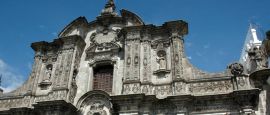Set at the base of the active Tungurahua volcano, Baños is a lively adventure hub known for thermal baths, waterfalls and outdoor activities. Visitors come for canyoning, biking, hiking, or simply to relax in the warm springs overlooking lush valleys.
Ecuador things to see and do
The highest peak in Ecuador and, due to the Earth's equatorial bulge, the point on the planet farthest from the centre of the Earth. Chimborazo's snow-capped summit dominates the surrounding highlands, and its national reserve provides superb opportunities for hiking, wildlife spotting and panoramic photography.
Located north of Quito, Cochasquí is one of the most significant pre-Inca archaeological sites in Ecuador. The complex features a series of large earthen pyramids and ceremonial platforms built by the Quitu-Cara people, surrounded by sweeping highland scenery. Its scale and preservation make it an intriguing place to explore ancient Andean astronomy, architecture and culture.
Home to one of the world's highest active volcanoes, Cotopaxi rises sharply from vast highland plains. The park offers hiking, horseback riding and wildlife spotting, with striking views of the snow-capped cone dominating the landscape.
Known for its elegant colonial buildings and riverside pathways, Cuenca is one of Ecuador's most charming cities. Museums, craft workshops and flower markets give it a gentle, artistic feel, while its cobbled streets make it ideal for leisurely wandering.
One of the world's most extraordinary wildlife destinations, the Galápagos offer close encounters with giant tortoises, marine iguanas, blue-footed boobies and playful sea lions. Each island has its own character, with volcanic landscapes, pristine beaches and exceptional snorkelling.
Ecuador's largest city has a lively waterfront, tropical parks and historic neighbourhoods. The Malecón 2000 promenade, with gardens and museums, and the colourful hillside district of Las Peñas make it a worthwhile stop, especially before or after visiting the Galápagos.
Ecuador's most important Inca archaeological site, Ingapirca showcases finely cut stone walls, ceremonial structures and the distinctive Temple of the Sun. Set in the highlands north of Cuenca, the site offers an intriguing glimpse into both Inca and Cañari cultures, framed by rolling Andean landscapes.
A lush region filled with hummingbirds, orchids and waterfalls, Mindo offers a gentler escape into nature. Visitors can enjoy birdwatching, zip-lining, chocolate tours and peaceful forest trails surrounded by misty greenery.
Famous for its vibrant market, Otavalo is one of South America's most important centres of indigenous culture and craftsmanship. Colourful textiles, handmade jewellery and traditional instruments fill the stalls, while nearby lakes and hills make for beautiful day trips.
Nestled in the high Andes east of Quito, Papallacta is known for its beautifully maintained thermal pools fed by volcanic waters. Surrounded by misty mountains and páramo scenery, it's an ideal place to unwind after exploring the highlands or before heading into the Amazon.
This turquoise volcanic lake sits in a dramatic caldera high in the Andes. Travellers can hike along the crater rim, descend to the water or explore nearby villages on the popular Quilotoa Loop, a multi-day walking route.
Ecuador's capital is a striking blend of Andean scenery and colonial architecture. Its UNESCO-listed Old Town is filled with ornate churches, grand plazas and narrow streets that spill down the hillsides. The city's high altitude gives sweeping views, especially from El Panecillo or the TelefériQo cable car.
Ecuador's Pacific coast offers excellent surfing conditions. The best surfing season typically runs from December to April, when the waves are strongest and the weather is at its most favourable. Popular spots include Montañita, the country's most famous surf town with lively beachfront breaks; Canoa, known for its long, mellow waves and relaxed atmosphere; and Mompiche, home to a renowned left-hand point break favoured by experienced surfers.
Ecuador's Amazon Basin is home to exceptional biodiversity and indigenous communities. Lodges in Cuyabeno Wildlife Reserve and Yasuni National Park offer canoe trips, wildlife walks and cultural experiences deep within the rainforest.
Do you have any Feedback about this page?
© 2025 Columbus Travel Media Ltd. All rights reserved. No part of this site may be reproduced without our written permission, click here for information on Columbus Content Solutions.








 You know where
You know where